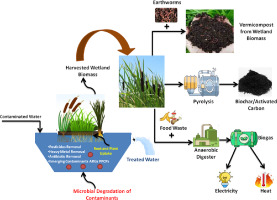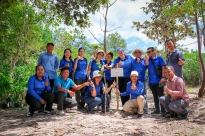Unlocking the potential of wetland biomass: Treatment approaches and sustainable resource management for enhanced utilization

Wetland is one of several habitats in the planet earth. It is crucial for recycling and retention of nutrients like Nitrogen, Phosphorus and Carbon (Moreau et al., 2013). The decentralized eco-systems under the name of constructed wetlands mimic the naturally occurring wetlands for the intention of treating contaminated water. Constructed wetlands have been developed as an alternative to traditional centralized wastewater treatment systems in the last 60 years due to their affordable and environmentally benign method of treating wastewaters (Vymazal, 2011a). Constructed wetlands have long been recognized as a dependable and acceptable treatment for a wide range of wastewaters and as a potential pollution removal option (Wu et al., 2018a). Wetland plants representing biomass are an integral part of constructed wetlands. As a result of intricate interactions between plants and species that are closely related to their roots, plants improve the environmental diversification in the area, which improves purification processes in addition to direct nutrient uptake (Vymazal, 2011b). However in the wetland, a lot of dead plant debris decomposes, returning nutrients to constructed wetlands and causing secondary pollution (Zhu et al., 2012). Therefore harvesting the wetland plants has been reported as one of the ways to enhance the effectiveness of constructed wetlands for long-term purification (Cui et al., 2016). However, a large quantity of wetland biomass must be recovered in order to maintain wetlands sustainably as well. Moreover, the environmental challenge of disposing of such solid wastes has gotten more challenging, and the majority of the wetland plant wastes are frequently burnt for use as fuel or dumped, causing pollution in land and atmosphere. However during the recent years wetland biomass has been viewed as a potential alternative feedstock source for bio-energy, bio-fertilizer and biochar (Cui et al., 2016). Wetland plants have also been discovered to be sustainable and substantially less expensive substrate for making activated carbon precursors, which could ultimately be used as a green and sustainable sorbent, notably in applications for treating wastewater (Wu et al., 2018b). Treating multiple types of environmental effluence, including the increasing agricultural waste, air pollution, and water pollution, might be accomplished by transforming these inexpensive wetland plants into value-added products like activated carbon or biochar, bio-fertilizers and bio oil.
Constructed wetlands are a popular choice for both centralized and decentralized treatment systems because they require minimal cost, small maintenance compared to standard wastewater treatment plants (Zhang et al., 2014). Around the world, 80 % of contaminated water is released into the surroundings without being treated, and approximately one billion individuals defecate in the outdoors (UNWWD, 2017). Municipal wastewater treatment facilities are quite effective in terms of the quantity of space they take up and the amount of carbon that they remove for a certain amount of money. However around 2.2 MJ of energy are used by municipal sewer treatment plants for every processed cubic meter of wastewater. Therefore, it costs a lot of money, and is complicated, therefore needs a lot of energy to run and maintain (McCarty et al., 2011). In the root zones of wetland macrophytes, wetlands use natural remedies which include biological and physical mechanisms to remediate many forms of wastewater (Kadlec and Wallace, 2008). Constructed wetland’s potential to offset greenhouse gas emissions and generate energy may be one of their most important advantages apart from treating wastewater (Liu et al., 2012a). When used as wastewater treatment systems, constructed wetlands consume significantly less energy amounting to 6.8 % of the energy that is needed by a conventional wastewater treatment plant (Shao et al., 2013).
Wetland plants are also essential to the fertility of the soil and crop productivity because they contain crucial plant nutrients and organic matter. Wetland biomass stands out for its inherent richness in phosphorus content, with levels ranging from 0.7 to 8.9 mg g-1. However, the pyrolysis process amplifies this already abundant phosphorus concentration within the biomass. As a result, wetland plant biochars exhibit a remarkable increase in phosphorus levels, ranging from 2.3 to 30.0 mg g-1. This concentration effect surpasses the phosphorus content found in biochars derived from commonly used agricultural residues, which typically range from 0.1 to 11.6 mg g-1. Thus, through pyrolysis, wetland biomass has the potential to be transformed into highly phosphorus-enriched biochar, capitalizing on its initial phosphorus-rich nature (Cui et al., 2022). Further wetland biomass exhibits significant richness in nitrogen content, and this inherent nitrogen concentration undergoes further enrichment through the pyrolysis process. During thermal treatment, the nitrogen present in wetland plants undergoes transformation into diverse inorganic nitrogen species such as NH4+ and NO3−, as well as organic nitrogen compounds including amines, imines, and N-heterocycles. Besides during the pyrolysis of wetland plants, specifically Alligator weed, Oenanthe javanica, and Typha angustifolia, a substantial proportion of the nitrogen content is preserved within the resulting biochar. Retention levels ranging from approximately 42.0 % to 67.5 % of the total nitrogen content can be observed in the biochar (Liu et al., 2011). This nitrogen-enriched biochar can effectively enhance soil fertility and nutrient availability, contributing to improved agricultural productivity and environmental sustainability. Besides the conversion to biochar the plants present in wetlands that contain nitrogen and phosphorus may be utilized as components for the manufacture of vermicomposts, which is another solution to the problem that is faced in reusing wetland plants. The vermicompost from wetland plants can be produced by thoroughly mixing the materials like wetland plants and manure. Clitellate earthworms are put to the compost piles after two weeks. In order to keep Clitellate earthworms safe from escaping and from being eaten by birds and other predators the compost piles are enveloped with plastic mesh. For the duration of the experiment, water is sprayed two times a week to keep the water content in desired range. Aeration is ensured by thoroughly mixing the piles at least twice a month (Raza et al., 2021). Vermicomposts made from wetland biomass has a greater nutrient content than inorganic fertilizers and can be a good quality green amendment for the growth of crops. Furthermore they can be used to recover nutrients also (Raza et al., 2022). However the wetland plants are typically removed using non-scientific techniques hence they may be detrimental if applied directly to soil since they may produce poisonous organic compounds as well (Sharma et al., 2018).
From the literature it is evident that wetlands offer a variety of environmental services that are beneficial to biological diversity, water treatment, stability of climate, food production, production of fiber, and storm resilience. Built-in wetland wastewater treatment systems can function as energy and water recovery systems and are thus fundamentally integrated systems. The value of wetland ecosystems remains overlooked or underestimated by stakeholders, governments, and the general public, primarily due to the fact that many of the services they provide have not been assigned a monetary value within the economic market (Jiang et al., 2011). As a consequence, wetlands continue to be at risk of loss or degradation (Owens, 2004). By critically analyzing the existing literature, it becomes evident that writing a review about the significance of wetland biomass utilization objectives, including the treatment of biomass, is essential for consolidating knowledge, identifying research gaps, promoting interdisciplinary collaboration, informing decision-making processes, and fostering innovation. By bringing together relevant information and perspectives, a comprehensive review contributes to advancing research, policy development, and sustainable resource management in the field of wetland biomass utilization.
This review article holds significant implications as it addresses multiple objectives. It explores treatment approaches to enhance the utilization of wetland biomass for specific products and high energy yields, promoting sustainable and efficient resource management. By highlighting the role of wetlands in sustainable practices, the study emphasizes their potential as multifunctional resources, including bio-energy generation, bio-fertilizer production, and treatment of wastewater. Additionally, the research identifies limitations and future perspectives in wetland biomass utilization, guiding future studies and driving innovation, policy development, and technological advancements. Overall, the findings contribute to reducing reliance on non-renewable energy sources, informing decision-making processes, and promoting the sustainable use of wetland resources for positive environmental, economic, and social outcomes. The review will help to bridge the gap between research findings and practical applications by highlighting the importance of understanding and optimizing biomass treatment methods. Furthermore, it facilitates informed decision-making and promotes the development of sustainable strategies for maximizing the utilization of wetland biomass resources.



